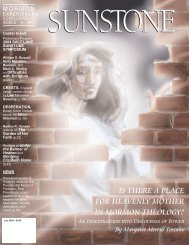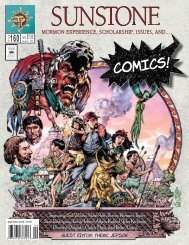Download Entire Issue PDF - Sunstone Magazine
Download Entire Issue PDF - Sunstone Magazine
Download Entire Issue PDF - Sunstone Magazine
Create successful ePaper yourself
Turn your PDF publications into a flip-book with our unique Google optimized e-Paper software.
S U N S T O N E<br />
imAg es : C. C. A. Ch r is t en s en : Det Ail s f r o m<br />
“s Ain t s Dr iv en f r o m JACk s o n Co u n t y mis s o u r i”<br />
Regarding the Danite expulsion of prominent Mormon<br />
dissenters, Sidney Rigdon told apostle Orson Hyde at Far<br />
West that “it was the imperative duty of the Church to obey<br />
the word of Joseph Smith, or the presidency, without question<br />
or inquiry, and that if there were any that would not,<br />
they should have their throats cut from ear [to] ear.”<br />
Remarkably, an official LDS newspaper later published this<br />
verification of the First Presidency’s 1838 authorization for<br />
theocratic killings. 82 Rigdon was, after all, merely restating<br />
in 1838 what the Prophet had said a year earlier about<br />
Grandison Newell—”that Newell should be put out of the<br />
way, or where the crows could not find him; he [Joseph<br />
Smith] said that destroying Newell would be justifiable in<br />
the sight of God, that it was the will of God, &c.”<br />
Benjamin Slade, a lifelong Mormon, soon testified that<br />
counselor Rigdon referred to carrying out that threat in mid-<br />
1838. “Yesterday a man had slipped his wind, and was<br />
thrown into the bush,” Rigdon told a closed-door meeting of<br />
Mormon men (apparently Danites), adding: “the man that<br />
lisps it shall die.” 83<br />
ON 4 July, a month before the county election, the<br />
First Presidency virtually dared the Missourians to<br />
try to stop Mormons from exercising their civil liberties:<br />
“It shall be between us and them a war of extermination,”<br />
counselor Rigdon warned, “for we will follow them,<br />
till the last drop of their blood is spilled, or else they will<br />
have to exterminate us.” 84 Joseph Smith published this<br />
Independence Day talk as a pamphlet, advertised it in the<br />
LDS periodical, and explained that Rigdon’s sermon expressed<br />
“the fixed determinations of the saints, in relation to<br />
the persecutors . . . for to be mob[b]ed any more without<br />
taking vengeance we will not.” 85<br />
Non-Mormons were determined to prevent Mormons<br />
from voting in Daviess County, which resulted in violence at<br />
the county seat of Gallatin in August 1838. “The first thing<br />
that came to my mind was the covenants entered into by the<br />
Danites,” wrote lifelong Mormon John L. Butler of this incident.<br />
He rallied the dozen other Mormons at the voting<br />
place by shouting: “O yes, you Danites, here is a job for us.”<br />
Among the Danites he rallied to fight the Missourians was<br />
Samuel H. Smith, Book of Mormon witness and brother of<br />
the LDS president. This account was included in the LDS<br />
Church’s official “Journal History.” 86 Although there were no<br />
fatalities, this election-day “battle” between self-professed<br />
Danites and anti-Mormons started a virtual civil war that engulfed<br />
four Missouri counties. 87<br />
In retaliation for raids against isolated<br />
Mormon farms, Mormon forces (primarily, if<br />
not exclusively, Danites) pillaged two non-<br />
Mormon towns. “There is no question,”<br />
wrote BYU professor William G. Hartley,<br />
“that Latter-day Saint rangers burned buildings<br />
at Millport and Gallatin,” including the<br />
U.S. post office and county treasurer’s office.<br />
In the most candid account ever written by a<br />
Utah Mormon historian about the Missouri Danites, he also<br />
acknowledged: “It is certain that some of the Missouri<br />
Danites played the thief, and it is possible, although unproven,<br />
that one or two were murderers.” 88<br />
However, Hartley’s comparison of the Danites with the<br />
National Guard was a flawed attempt at “balanced assessment,”<br />
since the Danites were religious vigilantes, not<br />
legally commissioned soldiers. Likewise, Hartley’s comparison<br />
fails in defining Danite atrocities as “wartime . . .<br />
military actions,” when in fact the Danite acts of “arson,<br />
vandalism, and robbery” were what they appeared to be,<br />
“clearly crimes” (his quotes). These Mormon crimes may<br />
have been understandable responses to even more savage<br />
attacks, but the retaliation was illegal by any definition.<br />
Worse, the Danites targeted a whole class of individuals—<br />
non-Mormons in general—rather than the specific perpetrators<br />
of the attacks for which Mormons sought<br />
revenge. 89<br />
Describing Danite security arrangements for August<br />
1838, the manuscript autobiography of loyal Mormon<br />
Luman A. Shurtliff revealed that Joseph Smith was also a<br />
Danite. Between two discussions of Danite “sighns [sic] and<br />
passwords” and the Danite “countersign,” Shurtliff noted<br />
how the LDS President and his brother Hyrum Smith (a<br />
Danite by mid-June 1838 as well as Joseph’s second counselor<br />
in the First Presidency) gave the necessary “countersign”<br />
as the two approached Shurtliff, who was the night<br />
sentry. A little further in his narrative, Shurtliff added that<br />
while he was on guard duty with newly appointed apostle<br />
John Taylor, “I did not feel at liberty to use any sighn [sic] or<br />
password” because “Br Taylor was not a Danite.” 90 However,<br />
like Hyrum, Joseph Smith was a Danite, and they both used<br />
the Danite countersign. 91<br />
Justus Morse, a Danite, listened to Joseph Smith authorize<br />
a Danite meeting (apparently after the Gallatin fight) to<br />
“suck the milk of the gentiles.” Morse, who remained loyal<br />
to the Prophet throughout his life, added that Smith explained<br />
“that we had been injured by the mob in Missouri,<br />
and to take from the gentiles was no sin,” merely retribution.<br />
92<br />
Danites who maintained lifelong loyalty to the LDS<br />
Church later wrote of what they did to defenseless “gentiles”<br />
during this “Mormon War” in Missouri. For example,<br />
twenty-year-old Benjamin F. Johnson participated in a raid<br />
that Danite captain Cornelius P. Lott led against an isolated<br />
settlement:<br />
OCTOBER 2011 PAGE 23

















